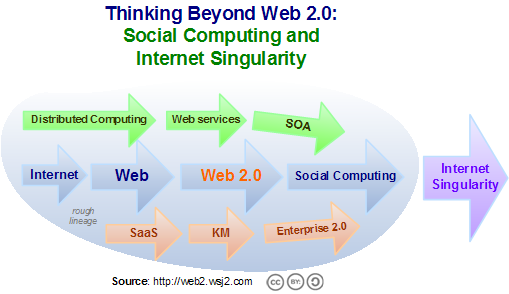I’m here in Sebastopol, California for O’Reilly’s yearly FOO Camp and consequently I’m in the mood for thinking beyond the signature topic of this blog and towards where things are headed next. As a good example of this, my colleague Jeremy Geelan has been closely following the possibilities here as well and has been investigating the ultimate ramifications of Web 2.0 and social software in general, a topic that Jeremy and others have been referring to as Social Computing. And looking even beyond this, though certainly as extensions of Web 2.0 and Social Computing, we have the complete collapsing together of all of our software and IT systems, something that Microsoft’s Gary Flake as referred to earlier this year during the launch of Live Labs as the Internet Singularity, which he describes as:
“The idea that a deeper and tighter coupling between the online and offline worlds will accelerate science, business, society, and self-actualization.” – Dr. Gary Flake
Of course, the effects of the next generation of the Web are just beginning to be felt and the world of software in 10 years will likely be somewhat recognizable by us, but only barely. I’ve been focusing recently on how we’re beginning to see vast and sudden changes in the way people are using the Web (and software in general) and citing the examples of YouTube and MySpace as exemplars of the dislocation that can happen suddenly as these new sea changes take place.

Naturally, this subject in general is a fascinating one and what some of us are hoping to discuss and uncover at places like FOO Camp and the upcoming The New New Internet, which we’re holding in Virginia next month. Both events and many others coming up show the interest in this topic and promise to chart out some of the answers to these difficult questions. In this vein of exploration, the diagram above contains some rough brainstorming of mine that provides a basic proximation of the lineage of trends as we watch Service-Oriented Architecture, Web 2.0, Enterprise 2.0, and other organizing principles in software, not so much merge but reflect the fact that they are really aspects of the same conceptual thing. This “same thing” (something I occasionally like to call the Timeless Way of Building Software) can look almost completely different depending on what we’re focusing on, despite having the same essential, constituent parts. In this new word, people and the relationships between them and the flow of control towards a more democratic model is this change in focus.
What do we do about all this? Developing strategies that map out, embrace, and enable the possibilities of course, but a lot of it will just happen to us of its own accord.
Finally, in the spirit of Web 2.0, I would love to encourage some contributed sound bites below describing how you believe the era of Web 2.0 will finish unfolding, please enter them in comments below. Also, more updates from FOO Camp shortly as it gets started tonight…
